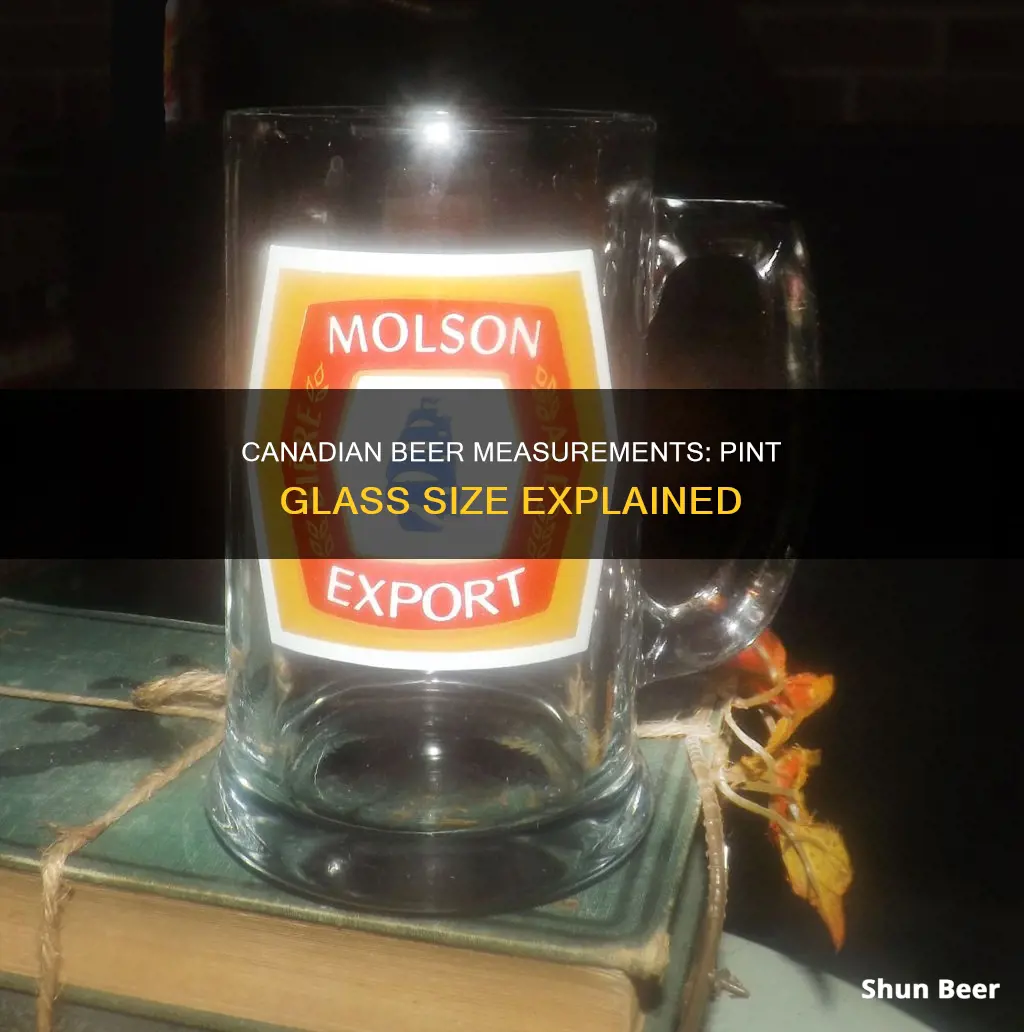
In Canada, a pint of beer is defined as 20 fluid ounces or 568 millilitres. This is the same as the British imperial pint, and is about 20% larger than the American pint. The Canadian pint is legally protected, but in practice, it is not always enforced, and some establishments may serve US pints or other measures and call them pints.
| Characteristics | Values |
|---|---|
| Volume | 20 fl oz |
| Volume (in mL) | 568 mL |
| Volume in US fl oz | 16 US fl oz |
| Volume in US fl oz (in mL) | 473 mL |
| Allowable limit of error | 0.5 fl oz |
| Allowable limit of error (in mL) | 15 mL |
What You'll Learn

A Canadian pint is 20 fl oz or 568 ml
In Canada, a pint of beer is defined as 20 fluid ounces or 568 millilitres. This is the same as the British imperial pint, and is about 20% larger than the American pint.
In Canada, businesses such as bars and restaurants are legally required to serve a stated amount within an allowable limit of error. The limit of error for a pint is 0.5 fluid ounces or 15 millilitres. This means that a "pint" that is less than 554 millilitres of beer is an offence, though this regulation is not always enforced.
The Canadian pint is defined in the Weights and Measures Act (R.S. 1985). Interestingly, this Act defines a pint in English as one-eighth of a gallon, but defines a pinte in French as one-quarter of a gallon. This means that ordering "a pint of beer" in English will get you an imperial pint (568 millilitres) of beer, but ordering "une pinte de bière" will get you an imperial quart (1136 millilitres). In Quebec, however, une pinte commonly refers to the same 568-millilitre imperial pint as in English.
The term "pint" should not be used to describe a glass or mug of beer, as this can lead to confusion. In Canada, it is better to sell beer by referring to glasses, mugs, or other drinking vessels.
The Vast World of IPA Beers
You may want to see also

This is 20% larger than a US pint
In Canada, a pint of beer is defined as 20 fluid ounces (568 millilitres). This is specified in the Weights and Measures Act (R.S. 1985), which states that a pint in English is one-eighth of a gallon. This is the same measure as the British imperial pint, which is about 20% larger than the American pint.
The discrepancy between the Canadian/imperial pint and the US pint dates back to the early 19th century. In 1824, the British Parliament replaced the various gallons in use with a new imperial gallon, which was based on the volume of ten pounds of distilled water at 62 °F (16.667 °C). This new definition made the Canadian pint incompatible with the American pint, which was based on the British wine gallon defined in 1707.
The larger size of the Canadian pint compared to its American counterpart is significant, as it means that drinkers in Canada are getting a larger serving of beer per pint. This difference in volume can impact the drinking experience and the price of beer. Some people may prefer the larger serving size, while others may find it too much and prefer smaller pours. From a cost perspective, a larger pint means that drinkers are getting more beer for their money, assuming the price remains the same.
While the Canadian pint is legally defined as 20 fluid ounces, there have been reports of bars and restaurants serving smaller portions. Some establishments may advertise a "pint" but serve only 18 or 16 fluid ounces, which is closer to the US pint size. This practice is illegal, and customers who feel they have been short-changed can file a complaint with the Government of Canada. To avoid confusion and ensure customers get what they pay for, it is recommended that establishments clearly indicate the size of the pour alongside the price.
Draught vs Lager Beer: What's the Real Difference?
You may want to see also

In Canada, a pint must be served within 0.5 fl oz of the stated amount
In Canada, a pint of beer is defined as 20 fluid ounces or 568 millilitres. This is the same as a British imperial pint, and it is about 20% larger than a US pint.
When a business advertises and sells a quantity of beer, it must serve the stated amount within a small margin of error. In Canada, the allowable limit of error for a pint is 0.5 fluid ounces or 15 millilitres. This means that a "pint" that is less than 554 millilitres of beer is an offence. However, this regulation is often violated and rarely enforced.
The term "pint" should not be used to describe a glass or mug of beer, as this could lead to confusion. Establishments are moving away from using the term "pint" and are instead selling glasses or "sleeves" of beer, which do not have a legal definition.
The foam (or head) of the beer is not included in the measurement. To avoid confusion, some pubs use lined or "oversized" glasses, with a line near the top to which the beer is poured, and the head forms above it.
Domestic vs Premium Beer: What's the Real Difference?
You may want to see also

The term pint shouldn't be used to describe a glass or mug of beer
In Canada, a pint of beer is defined as 20 fluid ounces or 568 millilitres. This is the same as the British imperial pint, and it is about 20% larger than the American pint.
Although the term "pint" is often used to describe a glass or mug of beer, this usage is not technically correct and could lead to confusion. This is because the actual volume of a "pint" can vary depending on the type of glass or mug being used, and different regions may have different standards for what constitutes a "pint".
For example, in the United States, two kinds of pints are used: a liquid pint (approximately 473 millilitres) and a less common dry pint (approximately 551 millilitres). In contrast, the imperial pint used in the United Kingdom and Ireland is approximately 568 millilitres.
Furthermore, the allowable limit of error for a pint in Canada is 0.5 fluid ounces (15 millilitres), and the foam (or "head") is not included in this measurement. This means that if a glass or mug is filled to the brim with beer, it may not actually contain a full pint once the foam is taken into account.
To avoid any confusion or misunderstandings, it is best to refer to the specific volume of beer being served rather than using the term "pint" to describe a glass or mug. This ensures that customers know exactly how much beer they are getting and helps to prevent any disputes over measurements.
Additionally, using the term "pint" to describe a glass or mug of beer could lead to legal issues, especially if the actual volume of beer served falls short of the customer's expectations. Establishments may find themselves facing complaints or even lawsuits if they are not clear about the measurements of their drinks.
In conclusion, while the term "pint" may be commonly used to describe a glass or mug of beer, it is not technically accurate and can lead to confusion, dissatisfaction, and even legal troubles. To ensure clarity and customer satisfaction, it is best to refer to the specific volume of beer being served rather than using the umbrella term "pint".
Exploring the Vast World of Beer: A Guide to Brands
You may want to see also

In Quebec, a pinte de bière is an imperial quart (1136 ml)
In Canada, a pint of beer is typically 568 ml, which is the same as an imperial pint. This is about 20% larger than a US pint. However, in Quebec, things are a little different. Here, the French word 'pinte' is used to describe an imperial quart, which is equal to 1136 ml. This is significantly larger than the standard Canadian pint. So, if you order "une pinte de bière" in Quebec, you will get a larger serving of beer than if you were to order a pint in English or in the rest of Canada.
The difference in serving size comes down to the historical use of different measurement systems in Canada. In Quebec, the French language and cultural influence have played a role in how beer is measured and served. The term "pinte" in Quebec refers to an imperial quart, while in the rest of Canada, it typically refers to an imperial pint.
The Weights and Measures Act (R.S. 1985) defines a pint in English as one-eighth of a gallon, but a "pinte" in French as one-quarter of a gallon. So, when ordering beer in Quebec, the language used makes a big difference in the amount of beer served. This unique usage of the term "pinte" in Quebec sets it apart from the rest of Canada and highlights the province's distinct cultural and linguistic heritage.
It is worth noting that, in practice, the term "une pinte" in Quebec is often used to refer to the same volume as an imperial pint (568 ml). This is supported by Quebec's Board of the French Language, which recognises that "une pinte" commonly refers to the standard imperial pint measurement. So, while the legal definition of "une pinte de bière" in Quebec is an imperial quart (1136 ml), in everyday usage, it may refer to the smaller imperial pint.
In summary, while a Canadian pint of beer is typically 568 ml, in Quebec, the term "une pinte de bière" legally refers to an imperial quart, which is 1136 ml. However, in casual conversation and in many drinking establishments, "une pinte" may simply refer to the standard imperial pint to avoid any confusion or legal issues.
Hazy IPAs: Unfiltered Bliss or Just a Fad?
You may want to see also
Frequently asked questions
In Canada, a pint of beer is 20 fluid ounces or 568 millilitres. This is the same as an imperial pint and is about 20% larger than a US pint.
A pint is a unit of volume or capacity in the imperial and United States customary measurement systems. It is equal to one-eighth of a gallon.
No, a Canadian pint is larger than a US pint. A US pint is 16 US fluid ounces or 473 millilitres.







